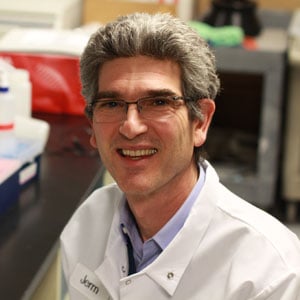
|
Depletion of a particular type of innate immune cell is the likely source of chronic inflammation in people living with HIV-1, according to new research published in Nature Immunology by a team lead by scientist Jeremy Luban, MD. The loss of innate lymphoid cells (ILC) may explain why people living with HIV-1 have increased rates of cardiovascular, liver, kidney and neurological disease associated with chronic inflammation, despite being on antiretroviral therapy.
One of the biggest medical miracles of our generation has been the development of antiretroviral drugs to control the HIV virus, said Dr. Luban, the David L. Freelander Memorial Professor in HIV/AIDS Research, professor of molecular medicine and lead author of the study.
“Today, the expectation is that, if you have access to antiretroviral drugs you can live a normal life span,” he said.
HIV-1 (human immunodeficiency virus) weakens the immune system by destroying important cells, specifically CD4+ T cells, that control infection. If HIV-1 is untreated, the virus reduces the number of CD4+ T cells in the body. This damage to the immune system makes it harder for the body to fight off infection. No cure exists for HIV-1. But with proper medical care, including antiretroviral drugs, HIV-1 can be controlled, and people can live normal life spans. Even with treatment, though, the human body can’t get rid of HIV-1 completely.
Patients with HIV-1 are now living longer thanks to these drugs. However, there are a growing number of reports that patients with HIV-1 experience increased rates of diseases associated with chronic inflammation, including coronary vascular disease, said Luban.
“Researchers have observed persistent structural abnormalities in the intestine of these patients and the barrier between the intestine and the blood,” said Luban. “For example, there have been reports of increased rates of bacterial products in the blood stream.”
Luban and colleagues started looking at innate lymphoid cells, a newly described type of innate immune cells, for a link. Among the many physiological roles these cells play is maintaining homeostasis in the tissues of the body, including the intestine. ILCs secrete cytokines that keep the cells of the intestine happy and maintain tight junctions between the cells so that they don’t leak.
Looking at blood and intestine tissue samples taken from HIV-1 positive patients, Luban and colleagues discovered that ILCs are severely depleted. “This is true of both people who are not being treated and for people who are on antiretroviral drugs,” he said.
Along with this permanent reduction in ILCs are signs of increased inflammation in both the intestines and blood stream. “This indicates that HIV causes permanent damage to the ILCs needed to maintain tissue health,” explained Luban. “This damage likely occurs during the acute phase of the infection, before the immune system starts controlling the virus, and the ILCs never come back.”
The Luban lab observed that natural killer (NK) cells, another innate immune cell type in the blood, were altered by the chronic inflammation that accompanies loss of the innate lymphoid cells in people with HIV-1. Using state-of-the-art technology, it was shown that these cells had expression profiles and chromatin structure resembling memory T cells. These surprising results showed that these innate immune NK cells actually possess memory properties that are normally only associated with T cells of the acquired immune system. It is believed that these memory NK cells may help control HIV-1 but also contribute to ongoing systemic inflammation.
“These innate lymphoid cells and NK cells are relatively rare cell types from patient samples,” said Luban. “Five years ago, we wouldn’t have been able to apply these methods to these cell types.
“We didn’t know that ILCs could become depleted,” he continued. “Now that we know these cells are gone, this provides a potential understanding for chronic inflammation in HIV patients. It raises the possibility of what can be done, can these cells be rescued?”
Related content on UMassMedNow:
Jeremy Luban explains need for more diverse genetic databases in new journal article
UMMS study identifies potential on/off switch for HIV-1
UMMS researchers receive amfAR grant to eliminate HIV reservoirs using gene editing
UMMS study suggests Ebola virus mutation caused recent outbreak
Jeremy Luban to New York Times: Ebola mutation fueled rapid spread